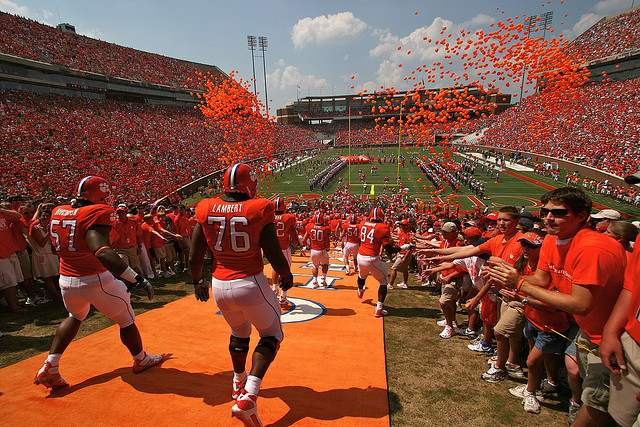ESPN To Enhance Coverage of Clemson’s Traditional Stadium Entrance
Network will leverage added RF to broadcast ‘the most exciting 25 seconds in college football’
Story Highlights
ESPN has a massive two days of college football in store with three Top 10 matchups on the docket (Stanford-Washington on Friday night, Wisconsin-Michigan and Louisville-Clemson on Saturday). It will be in Death Valley — for that nightcap between the Cardinals and the Tigers — where the most unusual and technologically challenging production of the weekend will take place.
Using added RF and camera resources, ESPN will provide exclusive live coverage of the Clemson football team’s traditional entrance into Memorial Stadium, which is capped by the historic “Run Down the Hill,” commonly known as “the most exciting 25 seconds in college football.”
“Whenever we do this at Clemson, it definitely becomes one of the harder shows that we do, just because of the geography and logistics,” says Jack Coffey, senior remote operations specialist, ESPN. “We’re doing RF everywhere, but I’ve got to get receive sites out in the street, well outside the stadium, which I normally wouldn’t do. Technically, it’s difficult. Nothing we do is brain surgery, but this one just requires running a lot of fiber to places that aren’t easy to get to.”
For those not familiar with Clemson’s iconic entrance, the Clemson football team leaves as a unit in full uniform from the Tigers locker room (which is located beneath the west end zone) and boards a series of buses. The team and coaching staff is then driven to the north end of the stadium, and the players file out and congregate at the top of a hill behind the east end zone. There the players rub Howard’s Rock, and a cannon shot sends them running down the hill and onto the field.
https://www.youtube.com/watch?v=yaNQpUQF0ao&feature=youtu.be
Dialing up efforts put into a similar live segment that the network produced twice in 2013, ESPN has deployed two additional RF receive sites outside the stadium in partnership with BSI and will position an RF Steadicam on the street to capture the buses as they roll around the stadium.
This year’s production will grant even more access than the 2013 editions: three in-car cameras (similar to those that one would see during an auto-racing production) have been added to the lead Clemson team bus. Previously, an RF Steadicam operator sat on the back of a pickup truck and shot the buses trailing behind. This year, with an on-board camera positioned on the dashboard of the lead team bus, viewers will get a first-person perspective.
Additional resources that will make this portion of the production possible include an additional RF Steadicam operator, who will run down the hill with the players; a fixed-wing aircraft flying above the stadium; and a jib outside the stadium.
ESPN is also deploying a massive Technocrane for the game production to capture the action of the team entrance from both inside and outside the stadium. The Technocrane is stationed in the student concourse section of the stadium and can be extended over a back wall of the stadium to capture the bus route outside. Then the operator can bring the arm back into the stadium for the players’ run down the hill.
“This is going to be a new perspective that we’ve never gotten at a football game before,” says Coffey, who also played a key role in ESPN’s production of the game between Tennessee and Virginia Tech at Bristol Motor Speedway. “It’s almost like a low-overhead shot.”
All of this added coverage will be run from the main game truck, Game Creek Video’s Spirit, and Coffey and his crew have just needed to make room for additional RF resources in the C unit.
All the work will add up to a dramatic moment that’s sure to be a highlight of a marquee weekend of college football on ESPN.
“It’s the gravity of the matchup,” says Coffey. “We want to see if there are things that we can add to the experience. We want to do this one step above every time we do it.”

